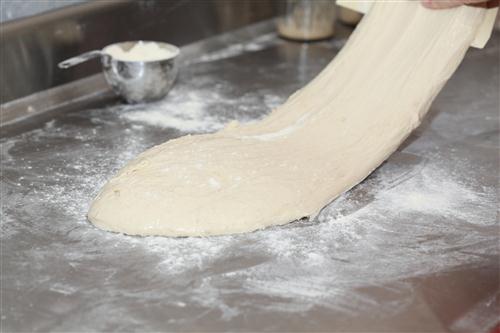
Stretching and folding is done to strengthen the dough during bulk fermentation
This little clip shows you how the technique of stretching and folding is executed. In the clip Ed uses the technique with a wholewheat sourdough 68% hydration dough. It is stretched and folded two times during bulk fermentation at 50 minute intervals. We use a flexible yet strong plastic scraper to help with the lifting and guiding of the dough.
You can find the complete recipe of our favorite wholewheat levain bread here.
The stretch and fold method helps to gently develop the gluten in your dough. It works very well with these higher hydration doughs. We like the technique very much because although you get to use your hands and feel the dough, it is not as tiring as actual kneading. It is great to see that by this gentle handling and a good amount of rest, you get amazing development in the dough and wonderful bread.



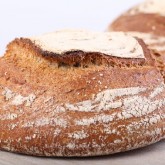
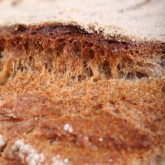
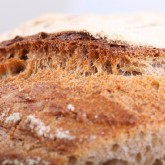
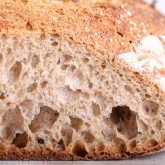
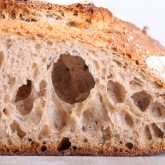
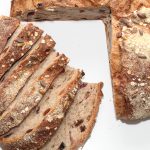

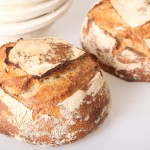
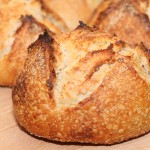
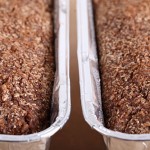

Alison Leathes says
I’m looking into purchasing a commercial bread dough mixer, (20l); does one still have to stretch and fold as in Sourdough bread dough?
Norman says
1. What is the duration of needed for slap N fold a poolish bread?
Nic T says
Hi, is it ok to mix (knead) bread dough using a metal bowl or does this negatively affect the result. ?
Thanks Nic T
Jen O says
This is very helpful and worked very well for my first try. So great to watch a hands on demonstration! Could you share which non-stick spray you use for bowl in the video? Thanks so much for any info!!
Weekend Bakers says
Hello Jen,
Thank you for finding it useful.
The spray you see in the video is called pancoating spay from this brand:
www.sonneveld.com/en/pr…formation/
Don’t know if it is ‘universally’ available, but alternatively coating the bowl with some basic olive oil works well too. The pancoating is especially helpful with bread pans and baking molds that need to be greased, because it makes sure there is an even layer on the whole surface. If you use oil only, you can get islands of oil and places where there is no oil at all. But you can get the same result / effect by using oil with a dusting of flour.
Enjoy your baking!
DR ALLEWANLY SHILLA says
I am a new home bread maker. During the COVID 19 lockdown I tried making bread and my first attempt was disastrous . The bread did not rise at all it’s just like a solid block of ?bread. I used to make high hydration dough but ended adding more flour to the dough with unsatisfactory results. I will try the stretch and fold technique as you have demonstrated . It looks so easy when you do it. I hope I will get a better result. Thanks for sharing the technique .
Weekend Bakers says
Hello DR ALLEWANLY SHILLA,
Making bread is a journey and you should not give up after a few attempts. The first thing to do is find a good recipe and make this same recipe over and over, at least 10 times. And try to avoid adding flour to the dough, but use a dough scraper or oil your hands to help with the stickiness. We can recommend taking a look at our best baking tips:
www.weekendbakery.com/posts…king-tips/
And the tips on how to handle wet dough:
www.weekendbakery.com/posts…ion-dough/
Try to enjoy the process without laying too much pressure on the end result. Even when the bread turns out less than perfect, you can almost always still eat it, toast it or use it to make bread crumbs and so on.
Greetings from Holland,
Marieke & Ed
WKB
george farmer says
What is the altitude where you bake your bread?
I live at 6,000′, in a dry climate. Can you suggest any adjustments to ingredients and/or technique that ,ay need to be considered?
Weekend Bakers says
Hello George,
We bake at about see level, so very different form your situation. The recent summer was very dry, but in general we have had a wetter climate.
We know you would need to up your hydration levels and temperature, but for more details we can recommend this post:
www.wheatmontana.com/conte…-mountains
Enjoy your mountain baking!
Bindu Chandrabose says
I LOVE this site, you guys are so helpful with your recipes and kind with guidance. One piece of advice i would give to people using the recipes in different conditions/locations: you have to do your own troubleshooting first.
I have been living in India for the last three years and there are so many modifications necessary to deal with (just as examples, not a complete list) different protein levels in flour, vastly different humidity levels, different amounts of butterfat in butter, yeast differences, small standalone ovens instead of the big Western ones. Before I start a recipe I look at every ingredient and step of the process before I begin so that I can minimize the amount of changes I will have to make on the next try.
Weekend Bakery are awesome, but sadly their powers are not superhuman in worldwide adaptation, you need to do your own work first ….
Good thing we have more time during these days of intermittent lockdowns!
Weekend Bakers says
Thank you so much Bindu for your kind words from experience. We agree with every word and hope other bakers will read them too and benefit from them!
Wishing you the best possible baking results (the way you go about it, you will succeed with anything!) under challenging conditions and lets hope times will always be good enough to bake.
Greetings from tiny Holland,
Ed & Marieke
Trent Talmage says
I noticed that on many of the recipes the dough is not greased or floured over when left to rest. How do you keep the dough from forming a skin? I never cover my dough but instead oil or flour it during the rise cycles. Is there something I am missing or will just covering the dough with a cloth or plastic wrap prevent the skin from forming?
Weekend Bakers says
Hello Trent,
We do protect our dough from drying out during rest and proofing. We used to cover it with floured cling film Which you can use multiple times), but more recently have moved to transferring the dough to containers with a lid, to avoid using too much plastic over and over.
we would always recommend using oil instead of flour. Because the flour will dry out your dough, get incorporated, attract moisture and interfere with the shaping too.
But in short, covering, whatever the method used, is always recommended.
James Cairns says
Do you need to knead the dough in stand mixer initially, wouldn’t it be better to just do more stretch and folds. I find that kneading the dough in a mixer tends to make the finished bread too dense. What do you think?
Weekend Bakers says
Hello James,
It depends on the objective and the recipe, but there is no ‘need to knead’. A lot of times it is easy to start with a shorter period of kneading to incorporate all the ingredients and get some gluten development and then it is easier to handle the dough for the first S&F. If you knead for longer and add S&F you could end up with a tighter crumb, but there can also be other factors at play like under-proofing or dough handling while shaping and hydration.
If you want to try a very excellent loaf with only S&F we can recommend the Tartine style as one of our favorites:
www.weekendbakery.com/posts…yle-bread/
Enjoy your baking!
Joseph Falcone says
Great Video.
Thanks.
Joe Falcone
USA
Weekend Bakers says
Thank you Joseph, it was made quite a while ago but it is still a very much preferred method of ours!
Christopher Williamson says
Pity the video won’t play in England
Weekend Bakers says
Sorry for that, we did not know, but we will look into it and see if we can change something so it will work again.
Peter Messenger says
The silly thing is, the first time I found this site I’m sure the video played (S&F with a bench blade, IIRC) but hasn’t played the last twice. Odd!
Weekend Bakers says
Hello Peter and Christopher,
We made a change and we thing this will do the trick and you will be able to see it again.
Let us know if this is the case?!
Snoop says
I see they didn’t reply. Just to let you know I’ve just viewed it in Spain. Brilliant video. Thanks.
Weekend Bakers says
Thanks for letting us know Snoop, much appreciated and happy baking in Spain!
Robin says
I’m watching with my niece, a budding baker, so that she can learn to stretch properly. We live 100 miles apart so it isn’t easy to get together for a lesson. She’s watching at her house, me at mine, and we’re chatting on Messenger. Technology, eh?
We have a question. She doesn’t have a 14% protein flour. Will dough enhancer help increase the protein? And if so, how much would she add per cup of flour? Thanks!
Weekend Bakers says
Hi Robin,
Thank you so much for your delightful comment. What a wonderful thing to still be able to share your baking, and overcome the distance this way. We love it!
About the flour: We are not sure what the ingredients in ‘dough enhancer’ are but we want to assume it is the same as extra gluten (something we call gluten powder over here). What amount you should add depends on the protein level (amount of gluten) of the flour she uses. Lets say it is 12% and you want to get it to 14% you have to add 2%. So if a bread recipe calls for 500 grams of flour, she must add 10 grams (2% of 500) to the flour.
Hope this helps and wishing you many happy baking moments apart and even more together.
Greetings from Holland,
Marieke & Ed
Evelien says
Hi Ed en Marijke,
Thank you for this video! The problem I keep experiencing with my dough when I do the stretch and fold is that it starts to tear when I want to stretch it, does this mean my dough is not moist enough? I mix and kneed by hand and always add the amount of water you prescribe in your recipes but it always remains a bit stiff and dry but adding more water makes the dough to sticky to kneed by hand. Any advise?
Weekend Bakers says
Hi Evelien,
It means that you did not develop enough gluten for the dough to be able to stretch. Could be your dough needs more kneading. Next to that the flour you use is very important. It needs to have enough protein for this purpose too. A protein of at least around 12% would be good. See our post on gluten also: www.weekendbakery.com/posts…ut-gluten/
Hope these tips help you.
Harris says
Hello,
does stretch & fold replaced the kneeding proccess? Or it it something done later one? And if this is the case, do you do them after the dough rises?
Weekend Bakers says
Hi Harris,
Yes, it can replace it partially or fully. We have some recipes like the 80% hydration baguettes and the Tartine style loaves, where the dough is developed by S&F only. Other recipes start with a shorter kneading cycle whereby the dough is further developed during bulk fermentation by usually 2 or 3 S&F turns every half hour or hour, depending on the recipe. See for example our Pain Naturel recipe for this.
Harris says
Yesterday I did the Tartine style bread. Excellent! I have a question on S&F.
I kneaded the dough and let it rest for 3-4 minutes. Then I did a S&F. The first stretch is done nicely since the dough is a little bit soft. I then turn the dough 90o degrees and stretch again. Then again.
In the third stretch dough seems more dense and a little bit more wet and stickyer. I rest it for 30 minutes. Then again S&F. And again the first two stretches are smooth, while in the third or fourth the dough is more sticky.
Do I do something wrong? Or this is a default behavior?
Thanks
Weekend Bakers says
Hello Harris,
This is perfectly alright. The dough is developing while resting. As you do the S&F you can stretch the relaxed gluten, but it will possibly become harder the more you stretch it (so your 3 and 4th one) and then again it needs to rest and relax. As you feel the resistance you should never go against that and pull the dough too hard so it will tear or be damaged. Just work with the dough and feel how much stretching it needs. It also depends on the amount of gluten in the flour and the type of flour you use (absorption of moisture can be different from ours, sometimes you also have to adjust the amount of water in a recipe).
Ferdi Tolenaar says
We’re making a Pain Naturel, but our dough is by far not that stretchy. Is every dough supposed to be this stretchy or can our less stretchy dough still be allright 🙂
Weekend Bakers says
Hi Ferdi,
It depends on the amount of gluten in the flour and how far they are developed in your dough. The quality and type of flour you use can make a big difference. You can read more about it here:
www.weekendbakery.com/posts…ut-gluten/
and here:
www.weekendbakery.com/posts…our-types/
For our bread baking we use flour (organic flour from the mill) with a gluten content of around 12.5% which works very well.
Although the result will be different, with a less developed dough, the bread will still be very tasty we are sure.
Beannie says
Hi. Thanks for the great video. I’m making your no knead rolls at present and have just watched the clip after two sets of folding. I didn’t stretch enough and used too much flour on my bench. We’ll see how they turn out.
Weekend Bakers says
Hi,
The good thing about bread is, that even with these ‘imperfections’ you will very probably end up with nice tasting rolls, plus you already figured out what to do even better next time!
Susan says
Hi Ed and Marieke,
Great video. Very helpful. Does it mean that the more SETS of stretch and fold will generate
a more open and holey crumb?
Thanks,
Susan
Weekend Bakers says
As long as the dough cooperates you can do the sets, but it is not a case of ‘the more the better’. In general our recipes form a good indication of how much is needed and if your dough lacks a bit of plumpness, you can do one more for instance, but as soon as the dough does not cooperate anymore, there is no need or use to go on with it. There is an optimum that you will find out by experience with your combination of ingredients and material.
Rene de Winter says
Dat ziet er top uit !!!!
Weekend Bakers says
Thank you Rene! We zijn ook nog bezig met een filmpje over ‘shaping’.